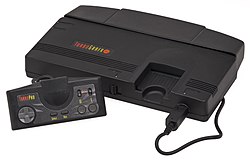
Back توربو غرافيكس-16 Arabic توربوجرافكس-16 ARZ PC Engine AST PC Engine Breton PC Engine Catalan TurboGrafx-16 Czech PC Engine German PC Engine Spanish توربوگرافاکس-۱۶ Persian PC Engine Finnish
This article needs additional citations for verification. (May 2023) |
  | |
  North American TurboGrafx-16 (top) and the original Japanese PC Engine (bottom) | |
| Manufacturer | NEC · Hudson Soft |
|---|---|
| Type | Home video game console |
| Generation | Fourth |
| Release date | |
| Lifespan | 1987–1994 |
| Discontinued | |
| Units sold |
|
| Media | HuCard |
| CPU | HuC6280 @ 7.16 MHz |
| Memory | |
| Display | Composite or RF TV out; 565×242 or 256×239, 512 color palette, 482 colors on-screen
|
| Graphics | |
| Sound | PSG, 5 to 10-bit stereo PCM |
| Best-selling game | Bonk's Adventure[2] |
| Successor | |
| Related | LaserActive |
The TurboGrafx-16, known in Japan as the PC Engine[a], is a home video game console developed by Hudson Soft and manufactured by NEC. It was released in Japan in 1987 and in North America in 1989. The first console of the fourth generation, it launched in Japan to compete with Nintendo's Famicom, but its delayed U.S. debut placed it against the more advanced Sega Genesis and later the Super NES.
The TurboGrafx-16 features an 8-bit CPU paired with dual 16-bit graphics processors, and supports up to 482 on-screen colors from a palette of 512. The "16" in the console’s North American branding was criticized as misleading.[3] With dimensions of 14 by 14 by 3.5 centimetres (5.5 in × 5.5 in × 1.4 in), the PC Engine remains the smallest major home console ever released.[4][5]
Games were initially released on HuCard cartridges, but the platform later supported additional formats requiring separate hardware: TurboGrafx-CD (CD-ROM² in Japan) games on compact disc, SuperGrafx games on a new console variant, and LD-ROM² games on LaserDisc via the LaserActive, a TurboGrafx-compatible system developed by Pioneer. No configuration supported all formats simultaneously. While the TurboGrafx-CD was moderately successful, the other two formats failed to gain traction. The resulting hardware fragmentation created consumer confusion.
The PC Engine was a commercial success in Japan, receiving strong third-party support and becoming the Super Famicom's main early competitor. In contrast, the TurboGrafx-16 struggled in North America due to limited marketing, a smaller game library, and its late release.[6] In Europe, Japanese models were grey-market imported and modified for local sale, but plans for an official release were canceled following poor U.S. performance.[7] Over 17 hardware variants were produced, including portable models and versions integrating the CD-ROM add-on.[8] Production of the final model ended in 1994. It was succeeded by the PC-FX, released exclusively in Japan, which was a commercial failure.
- ^ "Retro Sales Age Thread".
- ^ "Bonk's Adventure Virtual Console Review - Wii Review at IGN". Wii.ign.com. Archived from the original on April 14, 2012. Retrieved August 15, 2012.
- ^ Therrien, Carl; Picard, Martin (April 29, 2015). "Enter the bit wars: A study of video game marketing and platform crafting in the wake of the TurboGrafx-16 launch". New Media & Society. 18 (10): 2323–2339. doi:10.1177/1461444815584333. S2CID 19553739.
- ^ Guinness World Records Gamer's Edition (2008)
- ^ McFerran, Damien (November 2, 2012). "Feature: The Making of the PC Engine". Nintendo Life. Archived from the original on July 30, 2019.
- ^ Nutt, Christian (September 12, 2014). "Stalled engine: The TurboGrafx-16 turns 25". Gamasutra. Archived from the original on June 27, 2017.
- ^ Sartori, Paul (April 2, 2013). "TurboGrafx-16: the console that time forgot (and why it's worth re-discovering)". The Guardian. Archived from the original on July 1, 2018.
- ^ Stuart, Keith; Freeman, Will (February 27, 2016). "Why Kanye West is right to recommend the TurboGrafx-16". The Guardian. Archived from the original on June 22, 2017. Retrieved December 25, 2017.
Cite error: There are <ref group=lower-alpha> tags or {{efn}} templates on this page, but the references will not show without a {{reflist|group=lower-alpha}} template or {{notelist}} template (see the help page).
© MMXXIII Rich X Search. We shall prevail. All rights reserved. Rich X Search